instrument cluster INFINITI Q70 HYBRID 2014 Dismantling Guide
[x] Cancel search | Manufacturer: INFINITI, Model Year: 2014, Model line: Q70 HYBRID, Model: INFINITI Q70 HYBRID 2014Pages: 51, PDF Size: 3.65 MB
Page 9 of 51
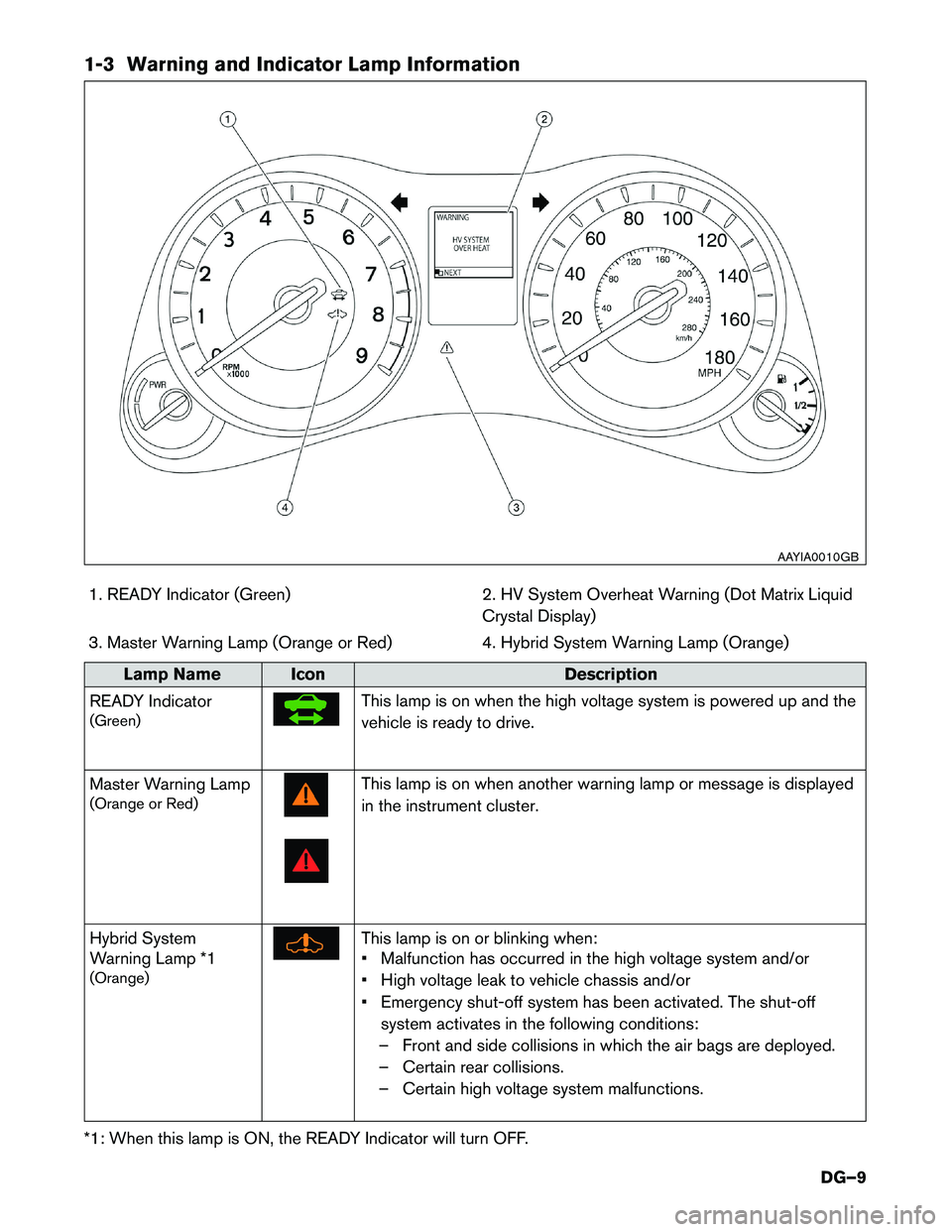
1-3 Warning and Indicator Lamp Information
1. READY Indicator (Green) 2. HV System Overheat Warning (Dot Matrix Liquid
Crystal Display)
3. Master Warning Lamp (Orange or Red) 4. Hybrid System Warning Lamp (Orange)Lamp Name Icon
Description
READ
Y Indicator
(Green) This lamp is on when the high voltage system is powered up and the
vehicle
is ready to drive.
Master Warning Lamp
(Orange or Red) This lamp is on when another warning lamp or message is displayed
in
the instrument cluster.
Hybrid System
Warning Lamp *1
(Orange) This lamp is on or blinking when:
•
Malfunction has occurred in the high voltage system and/or
• High voltage leak to vehicle chassis and/or
• Emergency shut-off system has been activated. The shut-off system activates in the following conditions:
– Front and side collisions in which the air bags are deployed.
– Certain rear collisions.
– Certain high voltage system malfunctions.
*1: When this lamp is ON, the READY Indicator will turn OFF. AAYIA0010GB
DG–9
Page 14 of 51
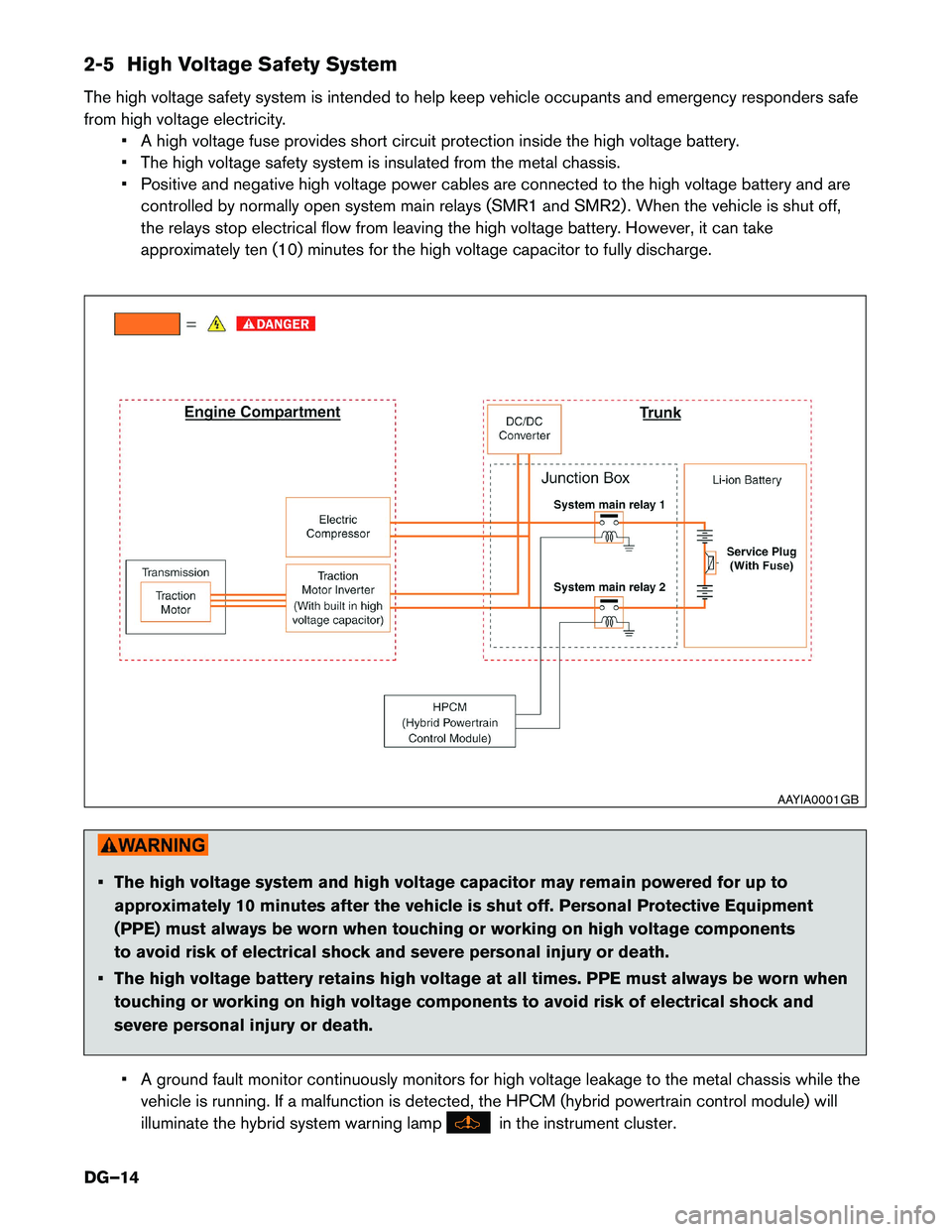
2-5 High Voltage Safety System
The
high voltage safety system is intended to help keep vehicle occupants and emergency responders safe
from high voltage electricity. • A high voltage fuse provides short circuit protection inside the high voltage battery.
• The high voltage safety system is insulated from the metal chassis.
• Positive and negative high voltage power cables are connected to the high voltage battery and arecontrolled by normally open system main relays (SMR1 and SMR2) . When the vehicle is shut off,
the relays stop electrical flow from leaving the high voltage battery. However, it can take
approximately ten (10) minutes for the high voltage capacitor to fully discharge. • The high voltage system and high voltage capacitor may remain powered for up to
approximately
10 minutes after the vehicle is shut off. Personal Protective Equipment
(PPE) must always be worn when touching or working on high voltage components
to avoid risk of electrical shock and severe personal injury or death.
• The high voltage battery retains high voltage at all times. PPE must always be worn when touching or working on high voltage components to avoid risk of electrical shock and
severe personal injury or death.
• A ground fault monitor continuously monitors for high voltage leakage to the metal chassis while the vehicle is running. If a malfunction is detected, the HPCM (hybrid powertrain control module) will
illuminate the hybrid system warning lamp in the instrument cluster. AAYIA0001GB
DG–14
Page 16 of 51
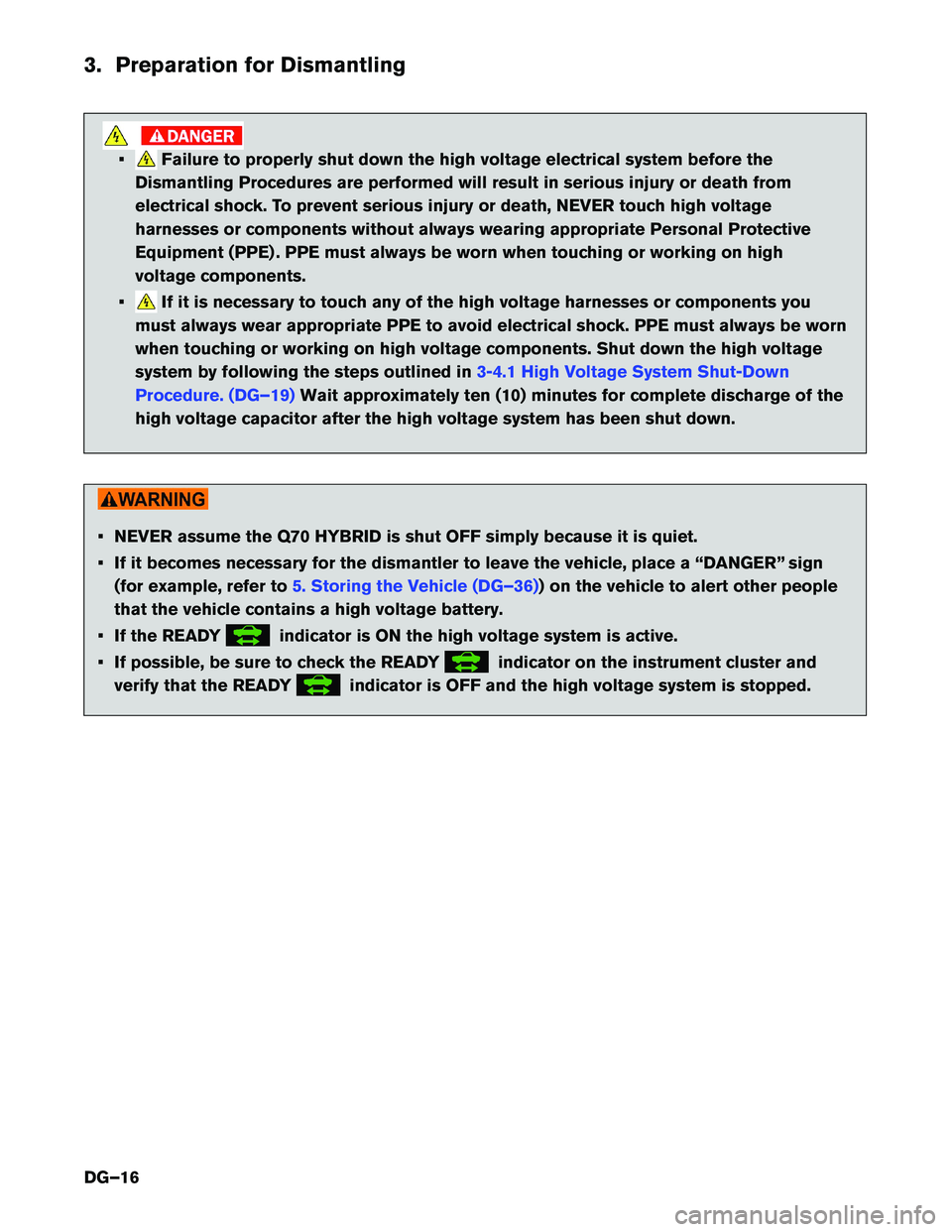
3. Preparation for Dismantling
• Failure to properly shut down the high voltage electrical system before the
Dismantling Procedures are performed will result in serious injury or death from
electrical shock. To prevent serious injury or death, NEVER touch high voltage
harnesses or components without always wearing appropriate Personal Protective
Equipment (PPE) . PPE must always be worn when touching or working on high
voltage components.
• If it is necessary to touch any of the high voltage harnesses or components you
must
always wear appropriate PPE to avoid electrical shock. PPE must always be worn
when touching or working on high voltage components. Shut down the high voltage
system by following the steps outlined in 3-4.1 High Voltage System Shut-Down
Procedure.
(DG–19) Wait approximately ten (10) minutes for complete discharge of the
high
voltage capacitor after the high voltage system has been shut down. • NEVER assume the Q70 HYBRID is shut OFF simply because it is quiet.
•
If it becomes necessary for the dismantler to leave the vehicle, place a “DANGER” sign
(for example, refer to 5. Storing the Vehicle (DG–36)) on the vehicle to alert other people
that
the vehicle contains a high voltage battery.
• If the READY indicator is ON the high voltage system is active.
•
If possible, be sure to check the READY indicator on the instrument cluster and
verify
that the READY indicator is OFF and the high voltage system is stopped.
DG–16
Page 18 of 51
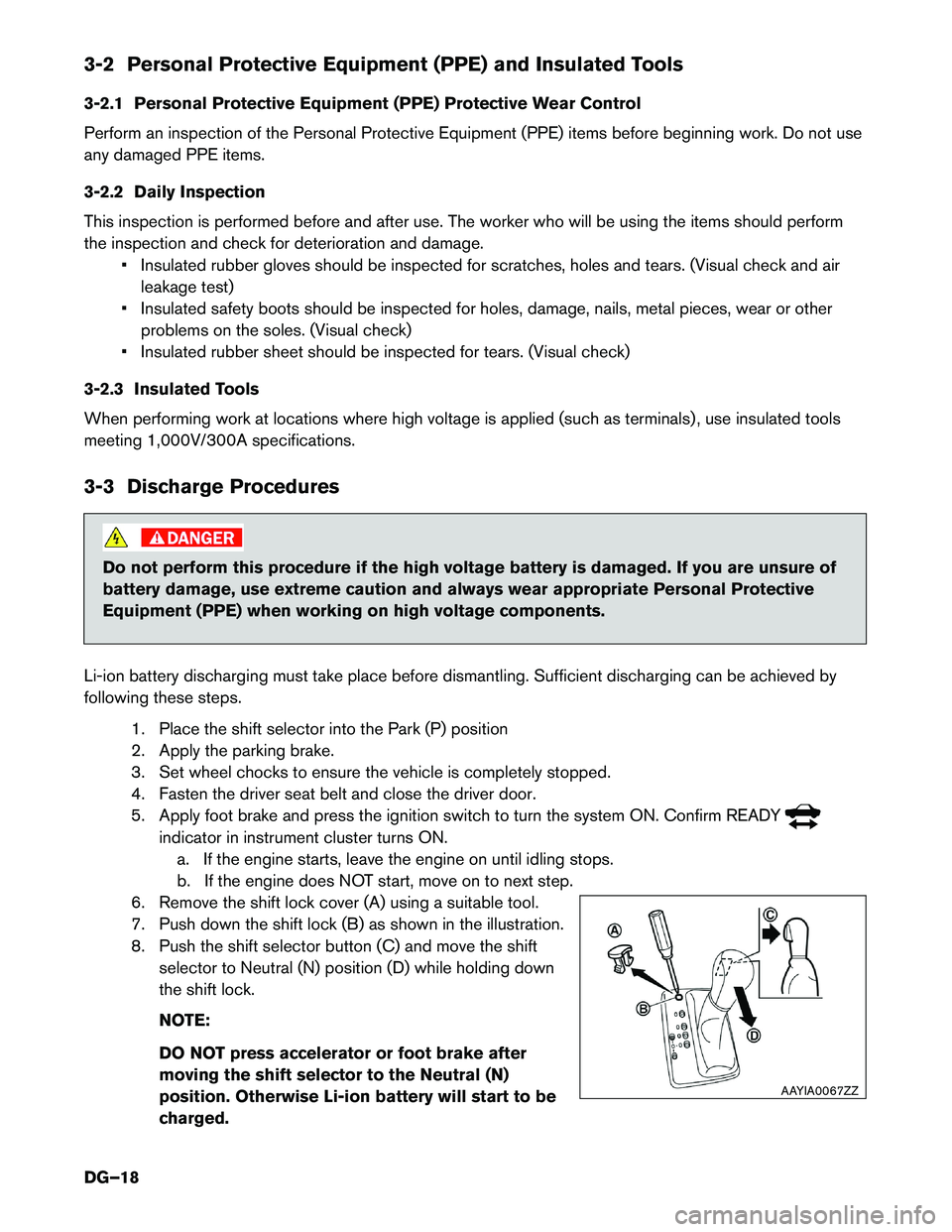
3-2 Personal Protective Equipment (PPE) and Insulated Tools
3-2.1
Personal Protective Equipment (PPE) Protective Wear Control
Perform an inspection of the Personal Protective Equipment (PPE) items before beginning work. Do not use
any damaged PPE items.
3-2.2 Daily Inspection
This inspection is performed before and after use. The worker who will be using the items should perform
the inspection and check for deterioration and damage. • Insulated rubber gloves should be inspected for scratches, holes and tears. (Visual check and airleakage test)
• Insulated safety boots should be inspected for holes, damage, nails, metal pieces, wear or other problems on the soles. (Visual check)
• Insulated rubber sheet should be inspected for tears. (Visual check)
3-2.3 Insulated Tools
When performing work at locations where high voltage is applied (such as terminals) , use insulated tools
meeting 1,000V/300A specifications.
3-3 Discharge Procedures Do not perform this procedure if the high voltage battery is damaged. If you are unsure of
battery
damage, use extreme caution and always wear appropriate Personal Protective
Equipment (PPE) when working on high voltage components.
Li-ion battery discharging must take place before dismantling. Sufficient discharging can be achieved by
following these steps. 1. Place the shift selector into the Park (P) position
2. Apply the parking brake.
3. Set wheel chocks to ensure the vehicle is completely stopped.
4. Fasten the driver seat belt and close the driver door.
5. Apply foot brake and press the ignition switch to turn the system ON. Confirm READY indicator in instrument cluster turns ON.
a.
If the engine starts, leave the engine on until idling stops.
b. If the engine does NOT start, move on to next step.
6. Remove the shift lock cover (A) using a suitable tool.
7. Push down the shift lock (B) as shown in the illustration.
8. Push the shift selector button (C) and move the shift selector to Neutral (N) position (D) while holding down
the shift lock.
NOTE:
DO NOT press accelerator or foot brake after
moving the shift selector to the Neutral (N)
position. Otherwise Li-ion battery will start to be
charged. AAYIA0067ZZ
DG–18
Page 20 of 51
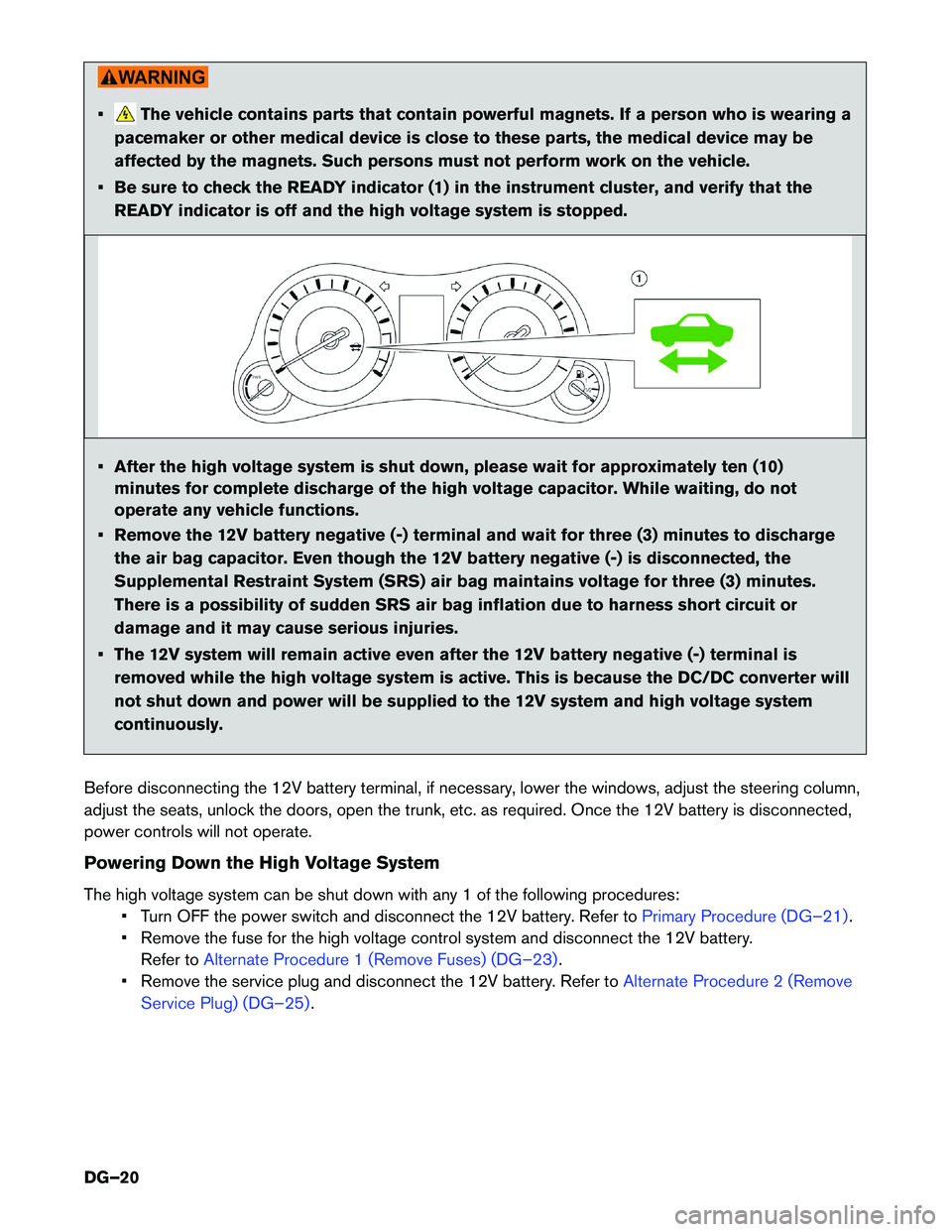
• The vehicle contains parts that contain powerful magnets. If a person who is wearing a
pacemaker or other medical device is close to these parts, the medical device may be
affected by the magnets. Such persons must not perform work on the vehicle.
• Be sure to check the READY indicator (1) in the instrument cluster, and verify that the READY indicator is off and the high voltage system is stopped.
• After the high voltage system is shut down, please wait for approximately ten (10) minutes for complete discharge of the high voltage capacitor. While waiting, do not
operate any vehicle functions.
• Remove the 12V battery negative (-) terminal and wait for three (3) minutes to discharge the air bag capacitor. Even though the 12V battery negative (-) is disconnected, the
Supplemental Restraint System (SRS) air bag maintains voltage for three (3) minutes.
There is a possibility of sudden SRS air bag inflation due to harness short circuit or
damage and it may cause serious injuries.
• The 12V system will remain active even after the 12V battery negative (-) terminal is removed while the high voltage system is active. This is because the DC/DC converter will
not shut down and power will be supplied to the 12V system and high voltage system
continuously.
Before disconnecting the 12V battery terminal, if necessary, lower the windows, adjust the steering column,
adjust the seats, unlock the doors, open the trunk, etc. as required. Once the 12V battery is disconnected,
power controls will not operate.
Powering Down the High Voltage System
The high voltage system can be shut down with any 1 of the following procedures: • Turn OFF the power switch and disconnect the 12V battery. Refer to Primary Procedure (DG–21)
.
•
Remove the fuse for the high voltage control system and disconnect the 12V battery.
Refer to Alternate Procedure 1 (Remove Fuses) (DG–23) .
•
Remove the service plug and disconnect the 12V battery. Refer to Alternate Procedure 2 (Remove
Service
Plug) (DG–25) .DG–20
Page 21 of 51
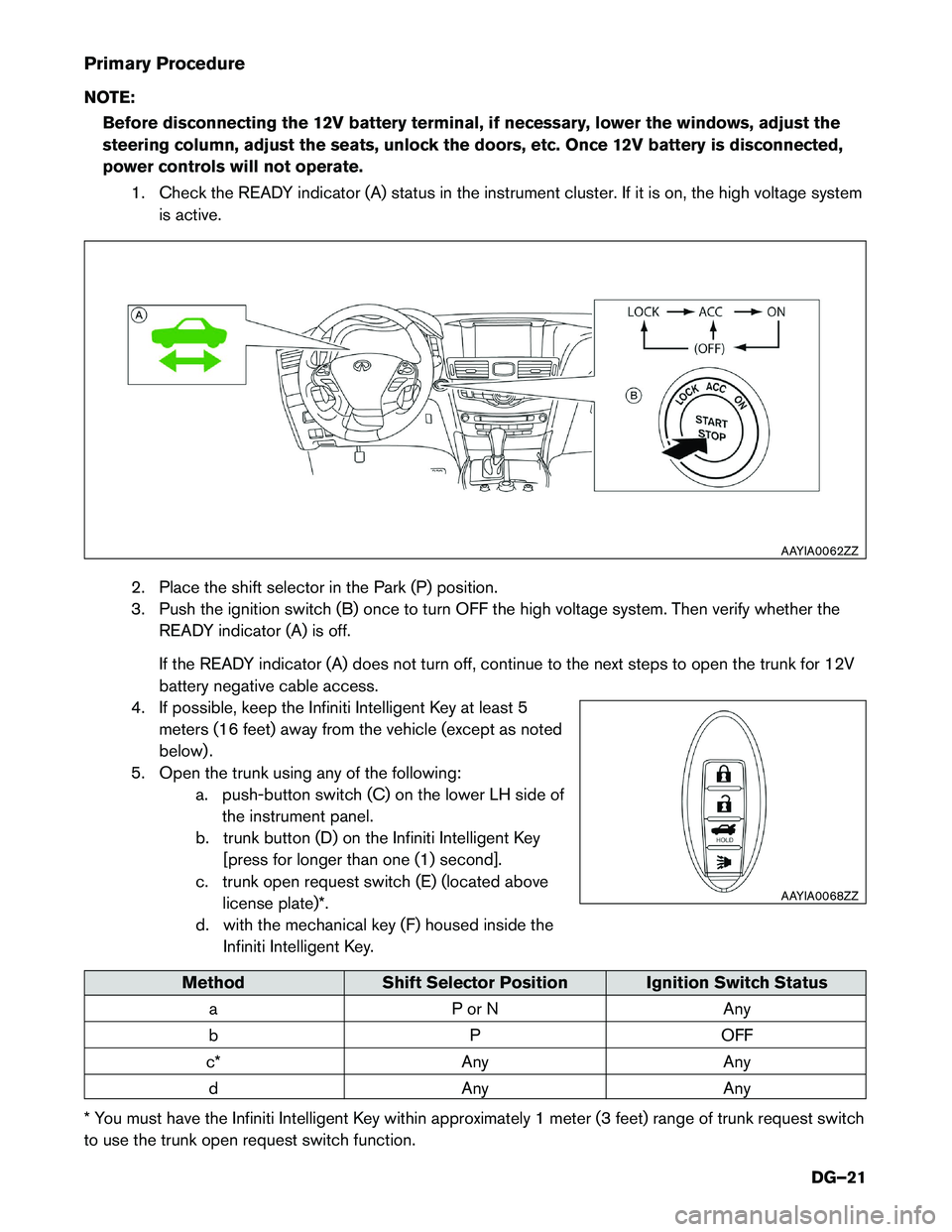
Primary Procedure
NO
TE:
Before disconnecting the 12V battery terminal, if necessary, lower the windows, adjust the
steering column, adjust the seats, unlock the doors, etc. Once 12V battery is disconnected,
power controls will not operate.
1. Check the READY indicator (A) status in the instrument cluster. If it is on, the high voltage systemis active.
2. Place the shift selector in the Park (P) position.
3. Push the ignition switch (B) once to turn OFF the high voltage system. Then verify whether the READY indicator (A) is off.
If the READY indicator (A) does not turn off, continue to the next steps to open the trunk for 12V
battery negative cable access.
4. If possible, keep the Infiniti Intelligent Key at least 5 meters (16 feet) away from the vehicle (except as noted
below) .
5. Open the trunk using any of the following: a. push-button switch (C) on the lower LH side ofthe instrument panel.
b. trunk button (D) on the Infiniti Intelligent Key [press for longer than one (1) second].
c. trunk open request switch (E) (located above license plate)*.
d. with the mechanical key (F) housed inside the Infiniti Intelligent Key. Method
Shift Selector Position Ignition Switch Status
a
P or N Any
b POFF
c* Any Any
d Any Any
* You must have the Infiniti Intelligent Key within approximately 1 meter (3 feet) range of trunk request switch
to use the trunk open request switch function. AAYIA0062ZZ
AAYIA0068ZZ
DG–21
Page 25 of 51
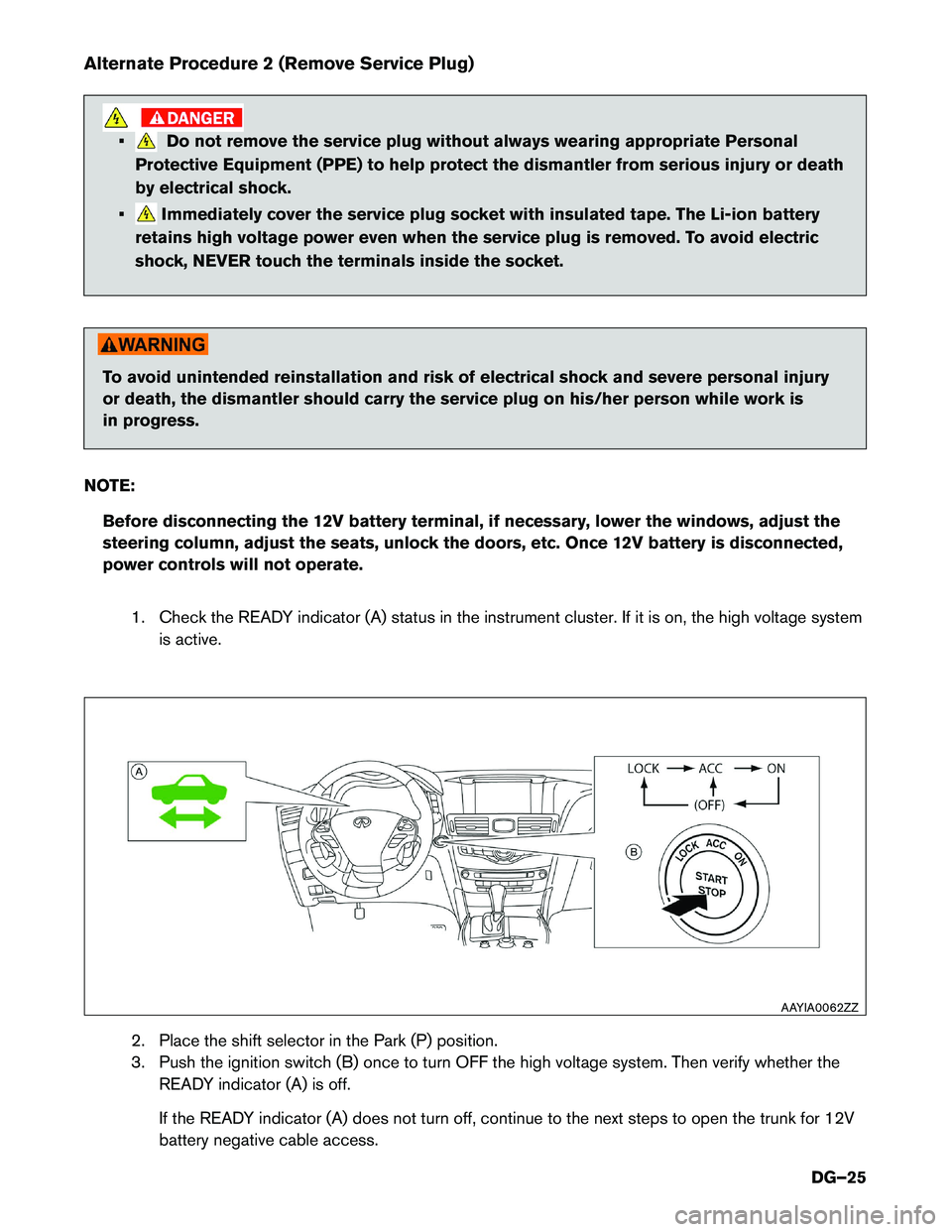
Alternate Procedure 2 (Remove Service Plug)
• Do not remove the service plug without always wearing appropriate Personal
Protective Equipment (PPE) to help protect the dismantler from serious injury or death
by electrical shock.
• Immediately cover the service plug socket with insulated tape. The Li-ion battery
retains
high voltage power even when the service plug is removed. To avoid electric
shock, NEVER touch the terminals inside the socket. To avoid unintended reinstallation and risk of electrical shock and severe personal injury
or
death, the dismantler should carry the service plug on his/her person while work is
in progress.
NOTE: Before disconnecting the 12V battery terminal, if necessary, lower the windows, adjust the
steering column, adjust the seats, unlock the doors, etc. Once 12V battery is disconnected,
power controls will not operate.
1. Check the READY indicator (A) status in the instrument cluster. If it is on, the high voltage systemis active.
2. Place the shift selector in the Park (P) position.
3. Push the ignition switch (B) once to turn OFF the high voltage system. Then verify whether the READY indicator (A) is off.
If the READY indicator (A) does not turn off, continue to the next steps to open the trunk for 12V
battery negative cable access. AAYIA0062ZZ
DG–25
Page 33 of 51
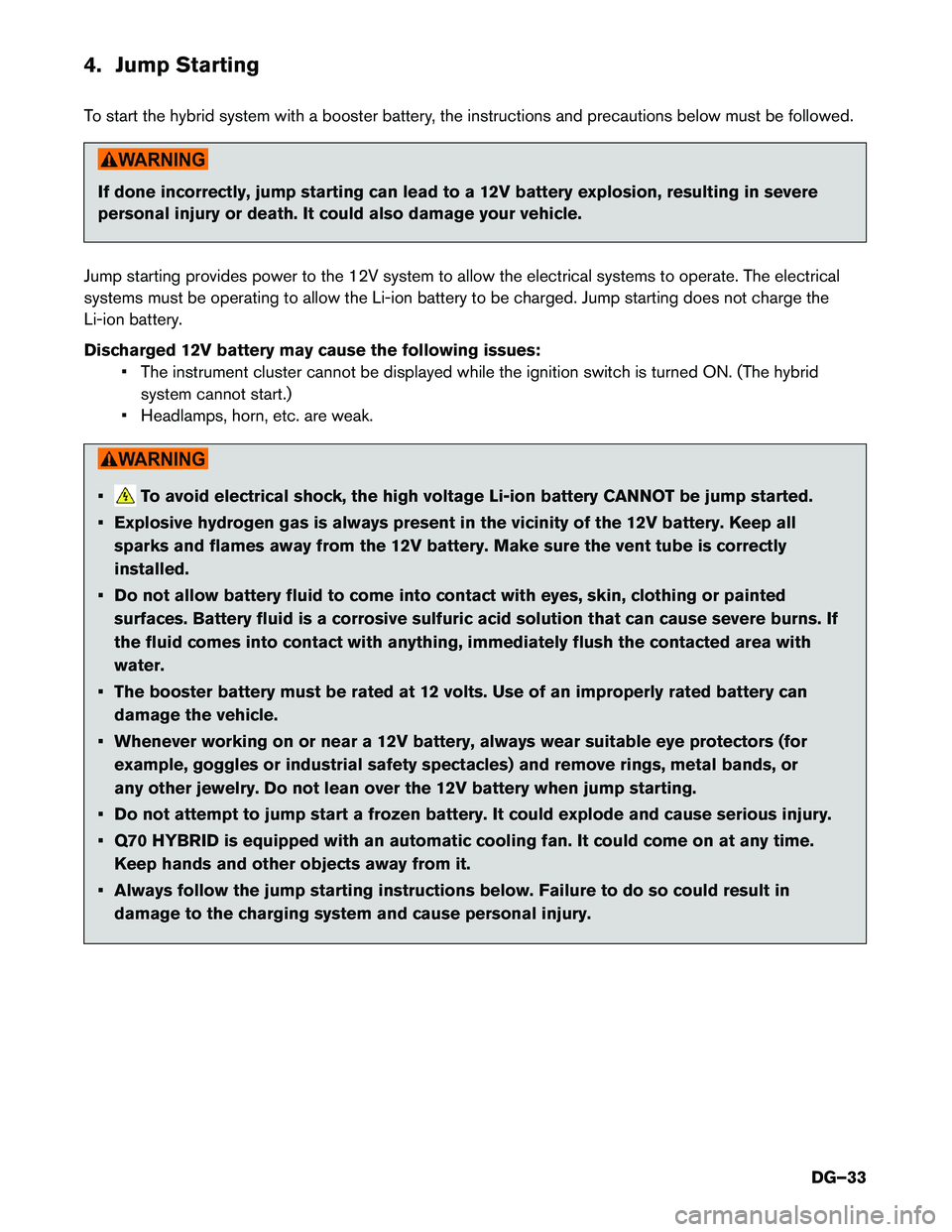
4. Jump Starting
T
o start the hybrid system with a booster battery, the instructions and precautions below must be followed. If done incorrectly, jump starting can lead to a 12V battery explosion, resulting in severe
personal
injury or death. It could also damage your vehicle.
Jump starting provides power to the 12V system to allow the electrical systems to operate. The electrical
systems must be operating to allow the Li-ion battery to be charged. Jump starting does not charge the
Li-ion battery.
Discharged 12V battery may cause the following issues: • The instrument cluster cannot be displayed while the ignition switch is turned ON. (The hybridsystem cannot start.)
• Headlamps, horn, etc. are weak. • To avoid electrical shock, the high voltage Li-ion battery CANNOT be jump started.
•
Explosive hydrogen gas is always present in the vicinity of the 12V battery. Keep all
sparks and flames away from the 12V battery. Make sure the vent tube is correctly
installed.
• Do not allow battery fluid to come into contact with eyes, skin, clothing or painted surfaces. Battery fluid is a corrosive sulfuric acid solution that can cause severe burns. If
the fluid comes into contact with anything, immediately flush the contacted area with
water.
• The booster battery must be rated at 12 volts. Use of an improperly rated battery can damage the vehicle.
• Whenever working on or near a 12V battery, always wear suitable eye protectors (for example, goggles or industrial safety spectacles) and remove rings, metal bands, or
any other jewelry. Do not lean over the 12V battery when jump starting.
• Do not attempt to jump start a frozen battery. It could explode and cause serious injury.
• Q70 HYBRID is equipped with an automatic cooling fan. It could come on at any time. Keep hands and other objects away from it.
• Always follow the jump starting instructions below. Failure to do so could result in damage to the charging system and cause personal injury.
DG–33